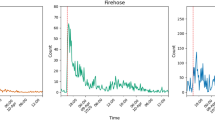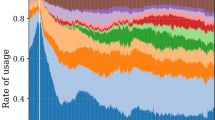Abstract
This mixed-methods study explores which types of journalists are on social media and what forms of knowledge-related utility they find there for their practice. We leverage computational techniques to identify more than 166,000 journalist profiles, in English, on Twitter and to examine their beats, follower counts, and volume of activity. We pair this with findings from an original 2019 survey with policy-oriented journalists (N = 450) who work on a variety of beats. Two-thirds of journalists believe social media tools help them frequently in their reporting work across many dimensions. Regression analysis finds significant associations with the technology and international affairs beats, as well as among younger journalists and those with a national audience. Our Twitter analysis, based on a dataset of 2.5 billion tweets collected in mid-2020, finds that the beats of politics, international affairs, and technology see the highest relative number of journalists on Twitter. The findings furnish a descriptive, quantitative picture of “Media Twitter” and speak to questions about social media’s place in journalism.
Access this chapter
Tax calculation will be finalised at checkout
Purchases are for personal use only
Similar content being viewed by others
References
Bell, E, et al.: The Platform Press: How Silicon Valley Reengineered Journalism. Tow Center for Digital Journalism (2017)
Bentivegna, S., Marchetti, R.: Journalists at a crossroads: are traditional norms and practices challenged by twitter? Journal. Theory Pract. Crit. 19(2), 270–290 (2018)
Benton, J.: The Fired New Yorker Writer Who Helped Birth Media Twitter Has Died (and I’m Sure He’d Apologize if He Could). Nieman Journalism Lab (2020)
Bobkowski, P.: Sharing the news: effects of informational utility and opinion leadership on online news sharing. Journal. Mass Commun. Q. 92(2), 320–345 (2015)
Bodrunova, S., Litvinenko, A., Ivan, B.: Please follow us: media roles in twitter discussions in the United States, Germany, France, and Russia. Journal. Pract. 12(2), 177–203 (2018)
Brems, C., Temmerman, M., Graham, T., Broersmab, M.: Personal branding on twitter. Digit. Journal. 5(4), 443–459 (2017)
Dianati, N.: Unwinding the hairball graph: pruning algorithms for weighted complex networks. Phys. Rev. E 93(1), 012304 (2016)
Dixon, P., Ellison, A., Nicholas, G.: Improving the precision of estimates of the frequency of rare events. Ecology 86(5), 1114–1123 (2005)
Du, Y., Masood, M.A., Joseph, K.: Understanding visual memes: an empirical analysis of text superimposed on memes shared on twitter. In: Proceedings of the International AAAI Conference on Web and Social Media, vol. 14, pp. 153–164 (2020)
Dubois, E., Gruzd, A., Jacobson, J.: Journalists’ use of social media to infer public opinion: the citizens’ perspective. Soc. Sci. Comput. Rev. 38(1), 57–74 (2020)
Fletcher, R., Schifferes, S., Thurman, N.: Building the ‘truthmeter’: training algorithms to help journalists assess the credibility of social media sources. Convergence 26(1), 19–34 (2020)
García-Perdomo, V.: Colombian journalists on twitter: opinions, gatekeeping, and transparency in political coverage. Int. J. Commun. 11(2017), 1574–1596 (2017)
Godler, Y., Reich, Z., Miller, B.: Social epistemology as a new paradigm for journalism and media studies. New Media Soc. 22(2), 213–229 (2020)
Grinberg, N., Joseph, K., Friedland, L., Swire-Thompson, B., Lazer, D.: Fake news on twitter during the 2016 US presidential election. Science 363(6425), 374–378 (2019)
Hanitzsch, T., Vos, T.: Journalism beyond democracy: a new look into journalistic roles in political and everyday life. Journalism 19(2), 146–164 (2018)
Henríquez-Coronel, P., Roca Guapacasa, G., Valecillos, C.: Engagement strategies of influential journalists on twitter Ecuador. In: 2020 15th Iberian Conference on Information Systems and Technologies (CISTI) (2020)
Jones, J.: Americans Endorse Reporter-Audience Social Media Interaction. Gallup Blog (2019)
Jukowitz, M., Mitchell, A., Shearer, E., Walker, M.: U.S. media polarization and the 2020 election: a nation divided deep partisan divisions exist in the news sources Americans trust, distrust and rely on. Pew Research Center (2020)
Lewis, S., Molyneux, L.: A decade of research on social media and journalism: assumptions, blind spots, and a way forward. Media Commun. 6(4), 11–23 (2018)
Lieberman, M.: A growing group of journalists has cut back on twitter, or abandoned it entirely. Poynter (2020)
McGregor, S.: Social media as public opinion: how journalists use social media to represent public opinion. Journalism 20(8), 1070–1086 (2019)
McGregor, S.C., Molyneux, L.: Twitter’s influence on news judgment: an experiment among journalists. Journalism 21(5), 597–613 (2020)
Molyneux, L., Lewis, S.C., Holton, A.E.: Media work, identity, and the motivations that shape branding practices among journalists: an explanatory framework. New Media Soc. 21(4), 836–855 (2019)
Neuberger, C., Nuernbergk, C., Langenohl, S.: Journalism as multichannel communication: a newsroom survey on the multiple uses of social media. Journal. Stud. 20(9), 1260–1280 (2019)
Persily, N., Tucker, J.: Social Media and Democracy: The State of the Field, Prospects for Reform. Cambridge University Press, Cambridge (2020)
Reich, Z., Lahav, H.: What on earth do journalists know? A new model of knowledge brokers’ expertise. Commun. Theory 31, 1–20 (2020)
Reich, Z.: The impact of technology on news reporting: a longitudinal perspective. Journal. Mass Commun. Q. 90(3), 417–434 (2013)
Santana, A., Hopp, T.: Tapping into a new stream of (personal) data: assessing journalists’ different use of social media. Journal. Mass Commun. Q. 93(2), 383–408 (2016)
Shugars, S., et al.: Pandemics, protests, and publics: demographic activity and engagement on twitter in 2020. J. Quant. Descr. Digit. Media 1 (2021)
Statista: Number of monthly active Twitter users worldwide from 1st quarter 2010 to 1st quarter 2019. https://www.statista.com/statistics/282087/number-of-monthly-active-twitter-users/. Accessed 13 Oct 2020
Tandoc, E., Jr., Vos, T.: The journalist is marketing the news: social media in the gatekeeping process. Journal. Pract. 10(8), 950–966 (2016)
Usher, N., Holcomb, J., Littman, J.: Twitter makes it worse: political journalists, gendered echo chambers, and the amplification of gender bias. Int. J. Press/Polit. 23(3), 324–344 (2018)
Vu, H., Le, T., Nguyen, H.: Routinizing facebook: how journalists’ role conceptions influence their social media use for professional purposes in a socialist-communist country. Digit. Journal. 1–19 (2020)
Weaver, D., Willnat, L.: Changes in US journalism: how do journalists think about social media? Journal. Pract. 10(7), 844–855 (2016)
Willnat, L., Weaver, D.: The American Journalist in the Digital Age: Key Findings. Indiana University, Bloomington (2014). http://news.indiana.edu/releases/iu/2014/05/2013-american-journalist-key-findings.pdf
Willnat, L., Weaver, D.: Social media and US journalists: uses and perceived effects on perceived norms and values. Digit. Journal. 6(7), 889–909 (2018)
Weaver, D., Wilhoit, C.: The American Journalist: A Portrait of U.S. News People and Their Work. Indiana University Press, Bloomington (1986)
Wihbey, J.P.: The Social Fact: News and Knowledge in a Networked World. MIT Press, Cambridge (2019)
Wihbey, J., Joseph, K., Lazer, D.: The social silos of journalism? Twitter, news media and partisan segregation. New Media Soc. 21(4), 815–835 (2019)
Wood-Doughty, Z., Xu, P., Liu, X., Dredze. M.: Using noisy self-reports to predict twitter user demographics. arXiv:2005.00635 (2020)
Zeng, L., Dailey, D., Mohamed, O., Starbird, K., Spiro, E.: Detecting journalism in the age of social media: three experiments in classifying journalists on twitter. In: Proceedings of the International AAAI Conference on Web and Social Media, vol. 13, pp. 548–559 (2019)
Author information
Authors and Affiliations
Corresponding author
Editor information
Editors and Affiliations
Rights and permissions
Copyright information
© 2022 The Author(s), under exclusive license to Springer Nature Singapore Pte Ltd.
About this paper
Cite this paper
Wihbey, J.P., Joseph, K., Reyes, D.R. (2022). Sizing Up “Media Twitter”: Exploring Population Extent, Beats, and Utility of Social Media. In: Rocha, Á., Barredo, D., López-López, P.C., Puentes-Rivera, I. (eds) Communication and Smart Technologies. ICOMTA 2021. Smart Innovation, Systems and Technologies, vol 259. Springer, Singapore. https://doi.org/10.1007/978-981-16-5792-4_54
Download citation
DOI: https://doi.org/10.1007/978-981-16-5792-4_54
Published:
Publisher Name: Springer, Singapore
Print ISBN: 978-981-16-5791-7
Online ISBN: 978-981-16-5792-4
eBook Packages: Intelligent Technologies and RoboticsIntelligent Technologies and Robotics (R0)




